Photographs
© Simon van Noort (Iziko Museums of South Africa).
|
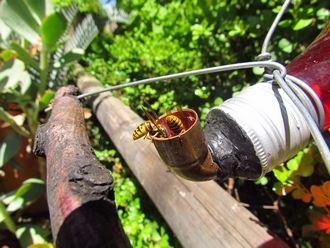 |
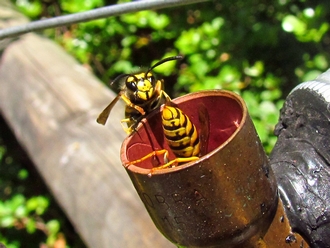 |
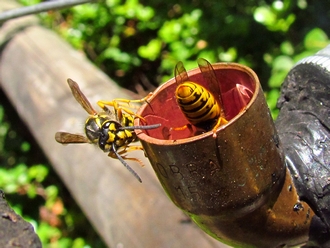 |
Vespula germanica foraging from a sucrose
sunbird feeder in Nico Laubscher's Stellenbosch garden (Photographs ©
Nico Laubscher). |
|
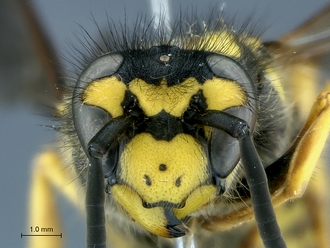 |
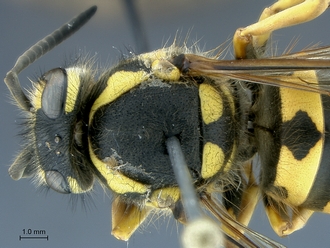 |
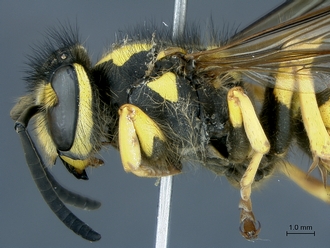 |
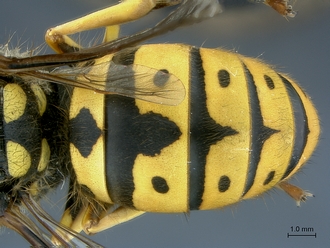 |
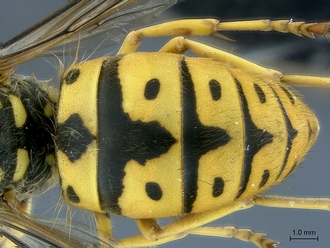 |
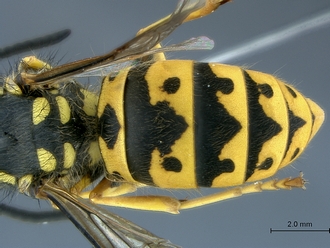 |
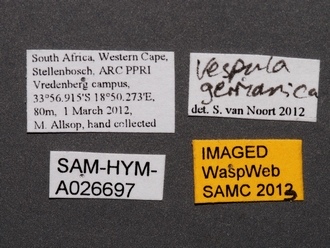 |
Photographs
© Simon van Noort (Iziko Museums of South Africa). |
|
Distribution
|
Indigenous to the Palaearctic region. Introduced into South Africa (Western Cape) in 1975
and
has the potential to spread through much of
the winter rainfall areas of South Africa. Also introduced
to
other parts of the world including Argentina, Australia,
Chile, New Zealand, USA.
|
Biology |
Social, constructing concealed communal paper nests often
under the ground. Larvae are fed
on chewed-up, soft-bodied insects such as caterpillars.
Can be a pest and incidental threat to picnickers as they are protein
scavengers, attracted to sugary substances and sting readily if
disturbed. Has potential impact on local ecosystems through prey
competition; the honey industry as they hunt bees; and on wine and fruit
industry through fruit feeding damage and subsequent secondary fungal
infection. Control: Destruction of nests.
|
Control
|
Wasp reporting tool for Cape Town invasive wasps.
Log your sighting to streamline the booking process for a control team. |
References |
Haupt K, Addison P, Veldtman R. 2019.
Fresh meat baits are currently the only available effective option to detect
low-density Vespula germanica (Hymenoptera: Vespidae) populations in
South Africa. Austral Entomology 58: 783-791.
https://doi.org/10.1111/aen.12393
Tribe, G.D. & Richardson, D.M. 1994. The European wasp,
Vespula germanica (Fabricius) (Hymenoptera: Vespidae) in southern Africa and
its potential distribution as predicted by ecoclimatic matching. African
Entomology 2: 1-6.
van
Noort, S. & Picker, M.
2011.
Wasps, Bees, Ants. Class Insecta, Order Hymenoptera.
Pp 140-146. In:
Picker,
M. & Griffiths, C. (eds.)
Alien & Invasive Animals. A South African perspective.
Struik Nature.
van Zyl C, Addison P, Veldtman R. 2018.
The invasive Vespidae in South Africa: potential management strategies and
current status. African Entomology 26: 267-285.
http://dx.doi.org/10.4001/003.026.0267
Whitehead, V.B. & Prins, A.J. 1975.
The European wasp,
Vespula germanica (F.), in the Cape Peninsula.
Journal of the Entomological Society of
Southern Africa 38: 39–42. |
Credits
|
Photographs
© Simon van Noort (Iziko Museums of South Africa) unless otherwise
indicated. Many thanks to
Derric and Nicholas Wilson for alerting me to the presence of these nests
and allowing access to their farm office for photography of the nest and
its inhabitants. The nest is now at Iziko South African Museum, where it
forms part of an exhibition on this alien invasive wasp.
|
|